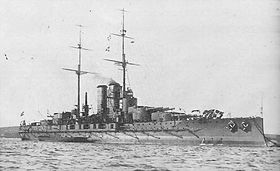- SMS Tegetthoff
-
SMS Tegetthoff 
SMS TegetthoffHistoire A servi dans Marine austro-hongroise 
Quille posée 24 septembre 1910 Lancement 21 mars 1912 Armé 14 juillet 1913 Statut détruit en 1924 Caractéristiques techniques Type cuirassé Dreadnought Longueur 159,94 m Maître-bau 27,28 m Tirant d'eau 8,58 m Déplacement 19 698 tjb Propulsion 4 turbines à vapeur
(12 chaudières)Puissance 27 000 ch Vitesse 20,4 nœuds Caractéristiques militaires Blindage ceinture = 280 mm
pont = 48 mm
kiosque = 250-356 mm
casemate = 180 mm
tourelle = 150-280 mmArmement principal :
(4x3) canons de 305 mm
secondaire:
12 canons de 150 mm (L50.Skoda)
18 canons de 70 mm
2 canons de 47 mm
4 tubes lance-torpille de 533 mmRayon d'action 4 200 milles nautiques à 10 nœuds (2 000 tonnes de charbon) Autres caractéristiques Équipage 1 087 Chantier naval Stabilimento Tecnico Triestino Trieste  Italie
Italiemodifier 
Le SMS Tegetthoff est un cuirassé Dreadnought de 1 e classe (Schlachtschiff) de classe Tegetthoff construit pour la Marine austro-hongroise (K.u.K. Kriesgmarine).
C'est le deuxième cuirassé, après le SMS Tegetthoff (1878), à porter le nom de Wilhelm von Tegetthoff ( 1827-1871), ancien amiral de la Marine austro-hongroise.
Sommaire
Conception
Les navires de classe Tegetthoff ont été parmi les premiers à utiliser des tourelles triples pour l'artillerie lourde.
Histoire
Avant la Première guerre mondiale, le Tegetthoff a été affecté à la 1e division cuirassée de la marine austro-hongroise. Il a participé, à le veille du conflit, avec ses sister-ships SMS Viribus Unitis et Prinz Eugen, à la fuite des deux navires allemands SMS Goeben et SMS Breslau du détroit de Messine, pour échapper à la flotte britannique.
Au début du conflit, le Tegetthoff a participé au bombardement de la ville italienne d' Ancône. Puis à cause du Barrage d'Otrante, immobilisant la flotte austro-hongroise en mer Adriatique, il resta dans le port de Pula.
En 1918, la flotte austro-hongroise tenta un raid pour la libération du blocus au Canal d'Otrante, et perdit le SMS Szent István. Après la fin de la guerre, le Tegetthoff fut remis à l'Italie dans le port de Venise. Il joua un rôle dans le film Eroi di nostri relatant le naufrage du SMS Szent István. Puis il a été abandonné puis démentelé à La Spezia en 1924-25.Voir aussi
Liens internes
Liens externes
- Tegetthoff class - site battleships-cruisers.co.uk
- AH Tegetthoff (site navalstory.flixco.info)
- Tegetthoff - site K.u.K. Kriegsmarine
- (en) Tegetthoff class - site croatian-treasure.com
Notes et références
- Robert Gardiner : Randal Grey edition (1984) Conway's All the World's Fighting Ships: 1906–1922 (ISBN 0-85177-245-5).
- (en) Cet article est partiellement ou en totalité issu de l’article de Wikipédia en anglais intitulé « SMS Tegetthoff » (voir la liste des auteurs)
- Portail de l'Autriche-Hongrie
- Portail du monde maritime
- Portail de l’histoire militaire
Catégories :- Cuirassé
- Nom de bateau
- Cuirassé de la marine austro-hongroise
- Bateau de guerre austro-hongrois
- Bateau des années 1910
Wikimedia Foundation. 2010.

